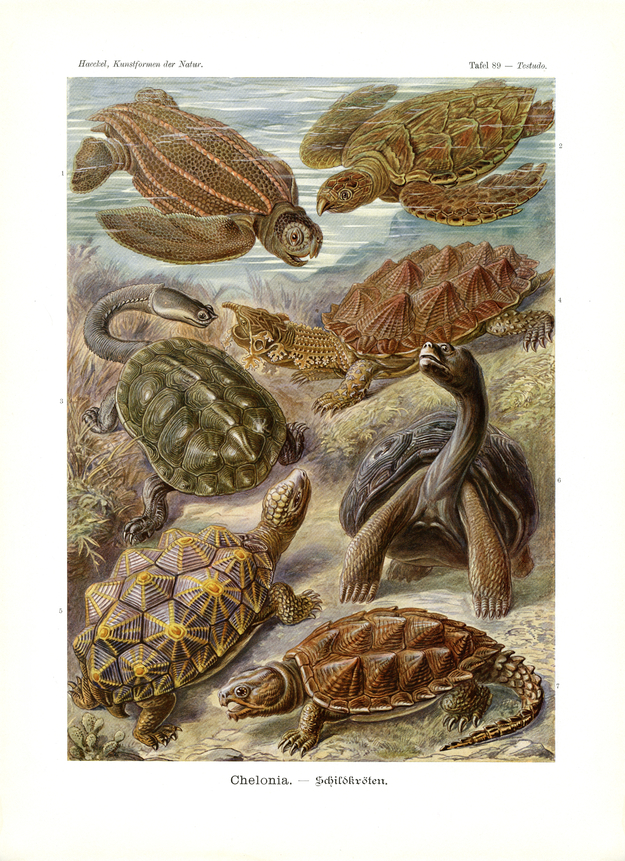Translation of the original German introduction by Ernst Haeckel:
Phylum of Vertebrata (Wirbeltiere); - main class of Gnathostoma (Kiefermäuler); - class of Reptilia (Schleicher); - legion der Chelonia (Schildkröten).
The peculiarly shaped legion of turtles (Chelonia) belongs to one of those ‘experts-groups’ of the class of reptiles that have departed from the original group of lizard-like Tocosauria through adaptation to distinct living conditions and habits. In contrast to the elongated body of most other reptiles the body of turtles is heavily shortened (similar to Batrachia, frogs and toads among the amphibians). The beak-like jaws are toothless. The major characteristic is the formation of a firm bone-shell that covers and protects the squat, broad and short body. Considering the historical development of this shell that consists of bones of the ‘leather-skin’ (like scales of fishes) two main stages are to be distinguished: the older ‘cobbled-tortoises’ and the younger hinge back tortoises. The old phylum group of ‘cobbled-tortoises’ (Atheconia) already existed, petrified, during ‘Thasformation’ (Psephoderma in Dachstein limestone) and in Cretaceous period (Protostega et al.); today only a single remnant exists, the peculiar leatherback turtle (Dermatochelys, fig. 1). The skin-skeleton of these Atheconia resembles that of older reptiles from which they originate (Anomodontia and Tocosauria); it is composed of numerous small bone pieces that rest separately in the leather skin or form a connected patch. The skin skeleton does not yet have a connection with the interior bone skeleton. Such connection, however, exists in the second main group, in the younger hinge back tortoises (Thecophora). Here the numerous small bone panels of the leather skin connect to form a rigid carapace that again firmly overgrows with the thoracic vertebrae and ribs. Just two big openings remain at this bone capsule: an anterior portal out of which head and front legs advance, and a posterior one for tail and hind legs. The epidermis that covers this shell of the leather skin remains soft only in the older Chelonia (‘skin-turtles’, Bursochelya); in younger ones (‘horn-turtles’, Cerachelya) it keratinizes and forms strong horn pieces that are used for technical purposes, known as “tortoiseshell”.
Translation by VR Translators Bangalore
We've scanned the original lithography at 1200dpi on the Epson A3 scanner of A3 scanner huren. You can download a 400dpi JPEG here.
